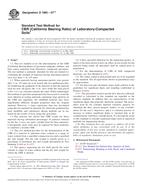Potrebujeme váš súhlas na využitie jednotlivých dát, aby sa vám okrem iného mohli ukazovať informácie týkajúce sa vašich záujmov. Súhlas udelíte kliknutím na tlačidlo „OK“.
ASTM D1883-07e2
Standard Test Method for CBR (California Bearing Ratio) of Laboratory-Compacted Soils (Includes all amendments And changes 1/21/2015).
Automaticky preložený názov:
Štandardná skúšobná metóda pre CBR ( Kalifornia Bearing Ratio ) laboratórne zhutnené pôd
NORMA vydaná dňa 15.11.2007
Informácie o norme:
Označenie normy: ASTM D1883-07e2
Poznámka: NEPLATNÁ
Dátum vydania normy: 15.11.2007
Kód tovaru: NS-18657
Počet strán: 9
Približná hmotnosť: 27 g (0.06 libier)
Krajina: Americká technická norma
Kategória: Technické normy ASTM
Anotácia textu normy ASTM D1883-07e2 :
Keywords:
Bearing ratio, California bearing ratio (CBR), Compression testing-soil, Earthwork, Foundation investigations, Loading tests-soil, Pavement surfaces, Penetration-soil, Recycled (paving) materials, Roadways, Soil-cohesionless, Soil-penetration, Soil-aggregate, Strength, Subbase, California bearing ratio of laboratory-compacted soils (pavement, subgrade/subbase/course materials), test, ICS Number Code 93.020 (Earth works. Excavations. Foundation construction. Underground works)
Doplňujúce informácie
| 1. Scope | ||||||||||||||||||||||||||||||
|
1.1 This test method covers the determination of the CBR (California Bearing Ratio) of pavement subgrade, subbase, and base course materials from laboratory compacted specimens. The test method is primarily intended for (but not limited to) evaluating the strength of materials having maximum particle sizes less than 3/4 in. (19 mm). 1.2 When materials having maximum particle sizes greater than 3/4 in. (19 mm) are to be tested, this test method provides for modifying the gradation of the material so that the material used for tests all passes the 3/ 4-in. sieve while the total gravel (+No. 4 to 3 in.) fraction remains the same. While traditionally this method of specimen preparation has been used to avoid the error inherent in testing materials containing large particles in the CBR test apparatus, the modified material may have significantly different strength properties than the original material. However, a large experience base has developed using this test method for materials for which the gradation has been modified, and satisfactory design methods are in use based on the results of tests using this procedure. 1.3 Past practice has shown that CBR results for those materials having substantial percentages of particles retained on the No. 4 sieve are more variable than for finer materials. Consequently, more trials may be required for these materials to establish a reliable CBR. 1.4 This test method provides for the determination of the CBR of a material at optimum water content or a range of water content from a specified compaction test and a specified dry unit weight. The dry unit weight is usually given as a percentage of maximum dry unit weight determined by Test Methods D 698 or D 1557. 1.5 The agency requesting the test shall specify the water content or range of water content and the dry unit weight for which the CBR is desired. 1.6 Unless specified otherwise by the requesting agency, or unless it has been shown to have no effect on test results for the material being tested, all specimens shall be soaked prior to penetration. 1.7 For the determination of CBR of field compacted materials, see Test Method D 4429. 1.8 The values stated in inch-pound units are to be regarded as the standard. The SI equivalents shown in parentheses may be approximate. 1.9 All observed and calculated values shall conform to the guidelines for significant digits and rounding established in Practice D 6026. 1.9.1 The procedures used to specify how data are collected, recorded or calculated in this standard are regarded as the industry standard. In addition they are representative of the significant digits that generally should be retained. The procedures used do not consider material variation, purpose for obtaining the data, special purpose studies, or any considerations for the users objectives, and it is common practice to increase or reduce significant digits or reported data to be commensurate with these considerations. It is beyond the scope of this standard to consider significant digits used in analytical methods for engineering design. 1.10 This standard does not purport to address all of the safety problems, if any, associated with its use. It is the responsibility of the user of this standard to establish appropriate safety and health practices and determine the applicability of regulatory limitations prior to use. |
||||||||||||||||||||||||||||||
| 2. Referenced Documents | ||||||||||||||||||||||||||||||
|
Odporúčame:
Aktualizácia technických noriem
Chcete mať istotu, že používate len platné technické normy?
Ponúkame Vám riešenie, ktoré Vám zaistí mesačný prehľad o aktuálnosti noriem, ktoré používate.
Chcete vedieť viac informácií ? Pozrite sa na túto stránku.




 Cookies
Cookies
